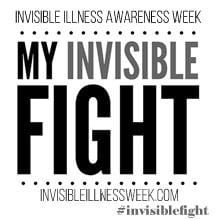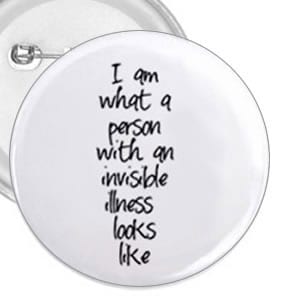
“A community cannot cure a disease, but it can greatly lessen the emotional impact it has on your life–and even on your physical body. By encouraging each other, we can decrease the isolation, give depression that can follow a diagnosis less power.” – Lisa Copen, 2015
Invisible Illness Awareness Week was established in 2002 as a way to reach out to those who have a chronic condition.

Since approximately 96% of those with a disability or illness have no visible symptoms, many people feel the emotions behind looking fine are often more difficult to deal with than the physical pain itself.
Every illness is unique, but what we rarely understand is that even among each individual, how his or her body responds to a specific chronic illness is unique as well. I was diagnosed with rheumatoid arthritis at the age of 24. What I quickly realized that even if I found another young woman diagnosed at the same age, with the same disease, on the very same day–we had different symptoms, side effects, emotions about it all, and experiences.
One of the reasons I began Invisible Illness Awareness Week in 2002 was because I noticed an overwhelming theme among those with illness. We generally could deal with the complications of our disease rather well. We schedule doctor’s appointments, we got second opinions, we tried therapies, medications and behaved as “good patient.” What kept us awake at night however, was not just the chronic pain, but the emotional frustration of feeling like we were fighting an invisible battle that no one knew about. We were giving every single day all of our energy, all of our motivation to keep going. We were trying so hard . . . and no one knew.
And not only did they not know, they made remarks about how we were handling our diagnosis: “You are just under too much stress . . . If I was on all those medications, I’d be sick too! . . . You are thinking about this too much . . . Is it really healthy for your kids to see you taking naps every day?” and the comments continued…
No one had any idea of amount of pain, the intensity of it, and how it was gradually destroying our lives. Rather than feeling cared for, we felt blamed for our illness.
And this–we had in common with others who were chronically ill. Even if we had disease with dramatically different symptoms. There are universal similarities–fatigue, fear, frustrations, and even motivations. Rather than closing ourselves off to only those with our disease–who often had different experiences anyway–we could gain so much by opening ourselves up to learning and encouraging anyone with a chronic illness.
Why do we talk about the “invisible” part? Because that was and is one of the main things we have in common–the fact that few people outside of our circle truly understand the pain and isolation that accompanies illness when you look completely well.
“I think that it’s great that Invisible Illness Awareness Week exists” says Nikki Lopez Mendez, who lives with depression. “Many people only believe what they see. When people look at me, they see someone who is outgoing, fun, confident, and witty. What they don’t see is that there are times I’m so paralyzed from depression that I don’t want to get out of bed, let alone go about regular daily activities.”
When I first started Invisible Illness Awareness Week we had chats each day on our website around topics that impacted people lives, from friendships to working, advocacy to parenting. I founded RestMinistries.com, a 501(c)3), in 1996. Invisible Illness Awareness Week has always been sponsored by Rest Ministries and Rest Ministries funds the entire venture. As a beginning kick off we spread the word among our own community, but this was in 2002, two years before Facebook existed. Those early years we reached out through press releases and in 2003 when MySpace began we had a page there.

Throughout the years, Invisible Illness Awareness Week has continued to grow and evolve. During the week we have had daily workshops via BlogTalkRadio where I never left my desk or headset except for bathroom breaks. My mom would fly down from Oregon for the week to help take care of my son, who was born in 2003, and make meals for us. We have had workshops pre-recorded via YouTube and chats via our Facebook page.
This year we are holding a series of 1-hour “chats” on our Facebook page. A special guest will help me post questions, and participants can comment to “post”. (Tip: Click Refresh to see the updated page)
Our amazing advocates who have chronic illnesses have used social media to make Invisible Illness Awareness Week an opportunity for anyone to get involved. Simple tweets, or posts on Tumblr can take on a life of their own, reaching hundreds of thousands of people. Thanks to our Facebook followers our outreach for the second week this past September was 4.2 million. We could never have done this on our own, and not with our small budget!
Here is how you can participate in this year’s Invisible Illness Awareness Week:
- Blog for the cause and link up your blog on our web site
- Fill out our 30 Things Meme which is 30 Things About My Invisible Illness You May Not Know
- Participate in IIWK Facebook Chats
- Check out our Pinterest Page
- Look around on Tumblr
Hosting Invisible Illness Awareness Week each year has been an honor.
I see so many people who are full-time advocates in the chronically ill online community, who do it without recognition. Many are quietly encouraging others from a laptop in their hospital bed or an ipad while getting an infusion.
I have met so many young adults who are eager to make a difference. They step forward and confront any stigmas associated with their disease head-on by holding a workshop or photography exhibit at their college. They make videos for all their friends and family to see. To be brave enough to reveal your inner struggles is hard at any age; to do it at 16 or 23 takes true courage.
This week a young woman commented on our webpage asking for advice. She is just about to get her driver’s license and will also be requesting a handicapped parking permit. She is already bracing herself for the moment when she is approached by a stranger who doubts her disabilities. But within a few hours over 60 people had encouraged her, shared some tips on what to say, reminded her of how to let those stares or comments slide off her without causing her feelings to plummet.
That we all have such a community to encourage, inspire, and vent is something that brings me great joy. It is what I longed for when I was 24 and newly diagnosed.
- Sara Cartwright, who has Complex Regional Pain Syndrome, says she shares memes and other information from Invisible Illness Awareness Week website “in the hope that the more information we get out there will stop the misinformation from spreading.”
- Kelly Fricke, an online advocate who is well known for her honesty and sweetness through her YouTube videos lives with a variety of invisible illnesses including Inflammatory Bowel Disease and Adenomyosis. “Invisible Illness Awareness Week shows those that suffer that we aren’t alone in our journey,” she says, “while also allowing those who don’t know about invisible illnesses the opportunity to understand and get perspective on our lives.”
With the support of the invisible illness community and the health organizations that support patient-founded advocacy, I am excited to see how Invisible Illness Awareness Week will continue to touch lives of both those with illness and without.
 About the Author: Lisa Copen is the founder of II Week, RestMinistries.com, and an author of a variety of books on chronic illness, including “Why Can’t I Make People Understand” and “Beyond Casseroles: 505 Ways to Encourage a Chronically Ill Friend.” She is also a homeschooling mom and shares a jewelry business with her husband designing pendants with purpose at http://GutsyGoodness.com . She has lived with rheumatoid arthritis and fibromyalgia since 1993 and is a survivor of neuro fasciitis, the flesh eating bacteria. She lives in San Diego with her husband and 12-year-old son.
About the Author: Lisa Copen is the founder of II Week, RestMinistries.com, and an author of a variety of books on chronic illness, including “Why Can’t I Make People Understand” and “Beyond Casseroles: 505 Ways to Encourage a Chronically Ill Friend.” She is also a homeschooling mom and shares a jewelry business with her husband designing pendants with purpose at http://GutsyGoodness.com . She has lived with rheumatoid arthritis and fibromyalgia since 1993 and is a survivor of neuro fasciitis, the flesh eating bacteria. She lives in San Diego with her husband and 12-year-old son.





